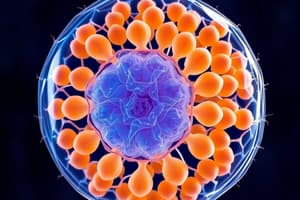Podcast
Questions and Answers
What are the main structural components of the Smooth endoplasmic reticulum (SER)?
What are the main structural components of the Smooth endoplasmic reticulum (SER)?
The Smooth endoplasmic reticulum is mainly made of tubules.
What is the primary function of the Rough endoplasmic reticulum (RER)?
What is the primary function of the Rough endoplasmic reticulum (RER)?
The primary function of the Rough endoplasmic reticulum is protein synthesis.
Explain the role of the endoplasmic reticulum (ER) in membrane biogenesis.
Explain the role of the endoplasmic reticulum (ER) in membrane biogenesis.
The ER helps in membrane biogenesis by synthesizing proteins and lipids needed for cell membrane formation.
Describe one function of the SER related to drug and toxin treatment.
Describe one function of the SER related to drug and toxin treatment.
Signup and view all the answers
What structures comprise the Golgi apparatus?
What structures comprise the Golgi apparatus?
Signup and view all the answers
How does the Golgi apparatus contribute to lysosome formation?
How does the Golgi apparatus contribute to lysosome formation?
Signup and view all the answers
What secretory functions does the Golgi apparatus perform?
What secretory functions does the Golgi apparatus perform?
Signup and view all the answers
Can you list a function of the Golgi apparatus related to cell structure?
Can you list a function of the Golgi apparatus related to cell structure?
Signup and view all the answers
What distinguishes the Golgi apparatus's presence in eukaryotic cells?
What distinguishes the Golgi apparatus's presence in eukaryotic cells?
Signup and view all the answers
Study Notes
Smooth Endoplasmic Reticulum (SER)
- Composed primarily of tubules
- Synthesizes steroids, lipids, and polysaccharides
- Lacks ribosomes
- Plays a crucial role in membrane biogenesis
Rough Endoplasmic Reticulum (RER)
- Consists of cisternae and vesicles
- Involved in protein synthesis
- Ribosomes are attached to its surface
Functions of the Endoplasmic Reticulum (ER)
- Serves as a transport system for materials within the cytoplasm and between the cytoplasm and nucleus
- Forms the endoskeleton of the cell, providing structural support
- Synthesizes fats, proteins, steroids, and cholesterol
- The SER detoxifies drugs and harmful byproducts
- Membrane biogenesis: Proteins and lipids produced by the ER contribute to the formation of cell membranes
Golgi Apparatus
- A series of membrane-bounded vesicles arranged in stacks called cisternae
- Contains large, spherical vacuoles
- Discovered by Camilo Golgi
- Absent in prokaryotes, mammalian red blood cells, and sieve cells
Functions of the Golgi Apparatus
- Stores, modifies, packages, and secretes cellular products in vesicles
- Forms lysosomes
- Plays a role in secretion
- Involved in melanin synthesis
- Contributes to the synthesis of the cell wall and plasma membrane
Studying That Suits You
Use AI to generate personalized quizzes and flashcards to suit your learning preferences.
Description
This quiz focuses on the structure and functions of the Endoplasmic Reticulum (both smooth and rough) and the Golgi Apparatus. Explore their roles in protein synthesis, lipid production, and cellular transport systems. Test your knowledge on how these organelles contribute to overall cell function.




